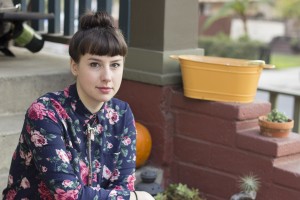Marika Stephens sat in the backyard of a craftsman house for two days to cut out paper hearts and craft flowers out of tissue paper.
After creating the decorations, she had a scant hour to help decorate a room in that house for filming a scene.
“That was really fun,” Stephens said of what she called arts and crafts time. “That’s the hands-on stuff that I don’t get to do as much anymore as an art director.”
Stephens, a UCLA alumna, was the art director for the film “To the Bone,” which was picked up by Netflix on Jan. 24 for $8 million after premiering at the Sundance Film Festival. Art directors have a supervisory role that doesn’t always allow for working in a hands-on way. They execute the production designer’s ideas by making sure the crews forset dressing, props, construction, painting and locations are communicating and completing their tasks, she said.
Stephens, however, found time to work directly on the set while overseeing four departments to ensure the set pieces were installed to create a cohesive image.
[Related: UCLA alumni to present horror-comedy series at Sundance 2017]
Stephens did not always know she would go into design. The granddaughter of UCLA alumnus and film actor Harvey Stephens, Stephens always wanted to be an actress, she said.
In herfreshman year of high school, she decided to audition for her school’s play. However, she missed the tryouts and, as an art enthusiast, decided to join the props and set painting crew instead.
“Once I did that I was like, ‘This is so much more fun,’” Stephens said. “Your work is seen onstage with everyone, and at the same time you don’t have to be onstage.”
She soon learned that she could study set design at university, and after creating a portfolio with the help of her high school play’s technical director, she was accepted into UCLA.

“Once the idea came into my head that I could design space – once I started doing it at UCLA and seeing what can happen when all the elements come together – it’s just magic,” Stephens said. “I know I can bring a strong visual sense to it, and that’s exciting to me.”
After graduating, Stephensworkedin the art department on television shows including “Awake,” “Excess Flesh” and “Criminal Minds: Beyond Borders.” A production designer with whom Stephens had previously worked introduced her to “To the Bone” production designer Maya Sigel.
Having met Stephens a year prior, when the art directors she usually works with were booked, Sigel decided to call Stephens to offer her the job on “To the Bone.”
“She has a good mix of practical skills as well as hands-on experience,” Sigel said. “You need to wear a lot of hats on a movie like this, and Marika is really great at working with other people and other departments.”
“To the Bone” follows a young womanEllen (Lily Collins) and her fight against anorexia with the help of her doctor (Keanu Reeves).
Stephens organized the crews to ensure that the set and artistic elements were consistent with Sigel’s and director Marti Noxon’s vision for the film, which was to raise awareness about eating disorders as truthfully as possible.
The graphic designer for the film collaborated with Stephens to create illustrations for the sketchbook that Ellen uses to draw throughout the film. Stephens said the drawings capture the mood of the film as it progresses, through images such as emaciated self-portraits, food drawn to seem delicious and disgusting simultaneously and portraits of those around Ellen as she tries to reach out to them.
[Throwback: Films to honor art direction]
Stephens also worked closely with Claire Macdonald, the film’s production assistant. Stephens had heard stories about PAs not being treated well, so she made an effort to introduce Macdonald to the roles within the art department and encouraged her to observe collaborative efforts between departments.
“Marika was welcoming and was willing to teach me,” Macdonald said. “She did a really great job organizing everything and she was able to talk to the production side really well, which made the job easier.”
When Stephens was up-and-coming, her superiors took the time to teach her, inspiring her to personally work with and teach Macdonald while art directing her first full-length feature film, she said.
“When you tell people that this is what you want to do, even if you’re overeager and naive, people will see that in you and want to help you get there,” Stephens said.
